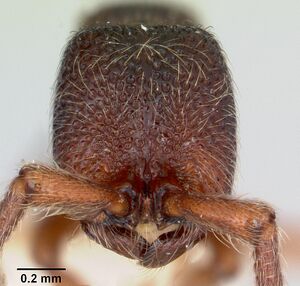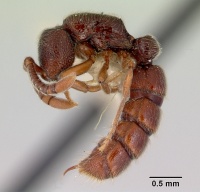Zasphinctus trux
| Zasphinctus trux | |
|---|---|

| |
| Scientific classification | |
| Kingdom: | Animalia |
| Phylum: | Arthropoda |
| Class: | Insecta |
| Order: | Hymenoptera |
| Family: | Formicidae |
| Subfamily: | Dorylinae |
| Genus: | Zasphinctus |
| Species: | Z. trux |
| Binomial name | |
| Zasphinctus trux (Brown, 1975) | |
Little is know about this species. One collection was taken from under a stone in a rainforest.
Identification
Distribution
Latitudinal Distribution Pattern
Latitudinal Range: -16.81666756° to -17.60000038°.
| North Temperate |
North Subtropical |
Tropical | South Subtropical |
South Temperate |
- Source: AntMaps
Distribution based on Regional Taxon Lists
Australasian Region: Australia (type locality).
Distribution based on AntMaps
Distribution based on AntWeb specimens
Check data from AntWeb
Countries Occupied
| Number of countries occupied by this species based on AntWiki Regional Taxon Lists. In general, fewer countries occupied indicates a narrower range, while more countries indicates a more widespread species. |

|
Estimated Abundance
| Relative abundance based on number of AntMaps records per species (this species within the purple bar). Fewer records (to the left) indicates a less abundant/encountered species while more records (to the right) indicates more abundant/encountered species. |

|
Biology
Castes
Images from AntWeb

| |
| Worker. Specimen code casent0172079. Photographer April Nobile, uploaded by California Academy of Sciences. | Owned by ANIC, Canberra, Australia. |
   
| |
| Type of Zasphinctus trux. Worker. Specimen code casent0173065. Photographer April Nobile, uploaded by California Academy of Sciences. | Owned by MCZ, Cambridge, MA, USA. |
   
| |
| Type of Zasphinctus trux. Worker. Specimen code casent0173066. Photographer April Nobile, uploaded by California Academy of Sciences. | Owned by MCZ, Cambridge, MA, USA. |
Nomenclature
The following information is derived from Barry Bolton's Online Catalogue of the Ants of the World.
- trux. Sphinctomyrmex trux Brown, 1975: 77, figs. 2, 101, 102, 105-113 (w.) AUSTRALIA (Queensland).
- Type-material: holotype worker, 21 paratype workers.
- Type-locality: holotype Australia: N Queensland, Atherton Tableland, Ravenshoe, 3000 ft, iv.1932 (P.J. Darlington); paratypes with same data.
- Type-depositories: MCZC (holotype); ANIC, BMNH, MCZC, MHNG (paratypes).
- Combination in Zasphinctus: Borowiec, M.L. 2016: 243.
- Status as species: Taylor & Brown, 1985: 52; Taylor, 1987a: 74; Bolton, 1995b: 392.
- Distribution: Australia.
Type Material
- Holotype, worker (plus 15 additional workers from same nest), near Ravenshoe, Atherton Tableland, Queensland, Australia, Museum of Comparative Zoology.
Holotype (Museum of Comparative Zoology) and 21 para types (ANIC-Canberra, BMNH-London, Museum of Comparative Zoology, MHN-Geneva) taken near Ravenshoe, on the Atherton Tableland, N Queensland, Australia at about 3000 ft. (900+ meters) in April 1932 by P. J. Darlington, Jr.
Unless otherwise noted the text for the remainder of this section is reported from the publication that includes the original description.
Description
Worker
Holotype: TL 4.7, HL 0.87, HW 0.76 (CI 87), ML 0.12, scape L 0.50, WL 1.16, petiolar node L 0.38, W 0.48, postpetiole L 0.50, W 0.64 mm.
Paratypes (21): TL 4.4-5.2, HL 0.84-0.94, HW 0.74-0.84 (CI 87-89), ML 0.12-0.15, scape L 0.47-0.54, WL 1.12-1.26, petiolar node L 0.40-0.44, W 0.44-0.50, postpetiole L 0.53-0.58, W 0.61-0.68 mm.
The figures show body form, pilosity, and some details of sculpture well enough; only features not, or poorly, shown or those needing emphasis will be described here.
Head with posterior border straight, extremely feebly concave in the middle as seen in full-face view, sides convex; eyes represented by pigmented dots at middle of sides of head, each without a distinct ommatidial facet. Frontal carinae with lobes sharply raised, subcontiguously converging and truncate behind; median carina of anterior slope of clypeus indistinct and forming only a low tubercle in full-face view. Anterior translucent apron of clypeus with a strongly convex border.
Mandibles triangular, with basal border rounding gradually into masticatory border, the latter finely crenulate on basal half, edentate on apical half; apex acute; external borders convex.
Labrum with a narrow median cleft in from the free margin; extensor surface with a transverse carina near midlength, in the middle forming a low, blunt transverse tubercle, also a small tubercle at either side of the labral shield, and a bluntly rounded tubercle or process at each side of an extension of the flexor face. Maxillary palpi 3-merous; first segment narrow; second segment long and broad, flattened, with a laterapical angle bearing 2 sensilla; apical segment small, its rounded apex bearing a single long sensillum. Labial palpi with a long, slender basal segment, subequal in length to the 2 shorter, broader distal segments taken together; apical and subapical sensilla 6-7.
Antennae with 12 distinct segments, all transverse except scape and apical segment, the last barely wider than preapical segment, and about 2 1/2 times as long. The sculpture fairly well for the petiolar disc in 112, but even here not all of the punctures near the center of the disc appear in the photograph; punctures of petiolar node decidedly smaller and more numerous than on truncal dorsum. Postpetiole and gastric terga all densely sown with punctures similar in size to those of the petiole, but much more numerous and crowded, many contiguous or subcontiguous, but all these surfaces nevertheless rather strongly shining. Pilosity of postpetiole and gaster, copious, suberect, with a conspicuous pubescence of appressed to decumbent, fine, short hairs. Antennae and legs punctulate, weakly shining, with long, fine decumbent pubescence (some longer suberect hairs on scapes); posterior faces of femora smooth and shining with scattered piligerous punctulae. Declivity of propodeum shining, microreticulate, with scattered piligerous punctulae.
Color medium brownish red; legs and antennae a little lighter and more yellowish.
References
- Borowiec, M.L. 2016. Generic revision of the ant subfamily Dorylinae (Hymenoptera, Formicidae). ZooKeys 608: 1-280 (doi:10.3897/zookeys.608.9427).
- Borowiec, M.L. 2019. Convergent evolution of the army ant syndrome and congruence in big-data phylogenetics. Systematic Biology 68, 642–656 (doi:10.1093/sysbio/syy088).
- Brown, W. L., Jr. 1975. Contributions toward a reclassification of the Formicidae. V. Ponerinae, tribes Platythyreini, Cerapachyini, Cylindromyrmecini, Acanthostichini, and Aenictogitini. Search Agric. (Ithaca N. Y.) 5(1 1: 1-115 (page 77, figs. 2, 101, 102, 105-113 worker described)
References based on Global Ant Biodiversity Informatics
- Brown W. L., Jr. 1975. Contributions toward a reclassification of the Formicidae. V. Ponerinae, tribes Platythyreini, Cerapachyini, Cylindromyrmecini, Acanthostichini, and Aenictogitini. Search Agric. (Ithaca N. Y.) 5(1): 1-115.

